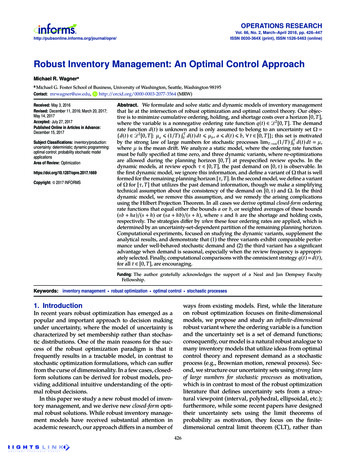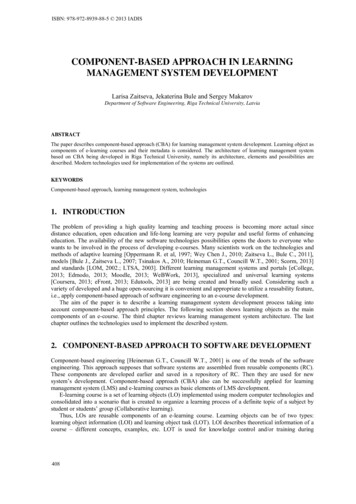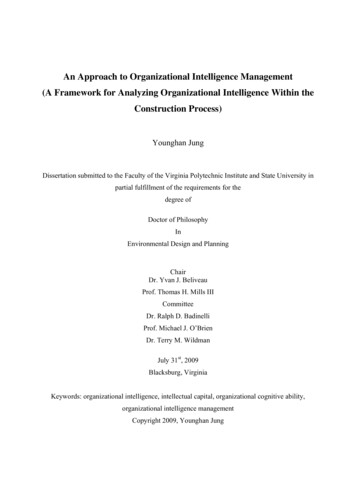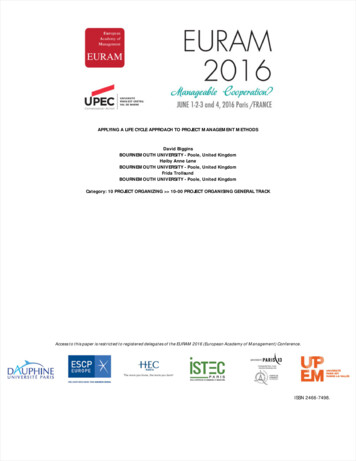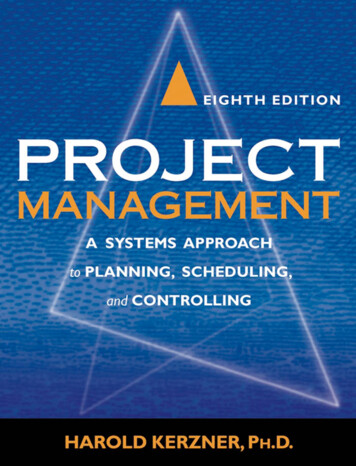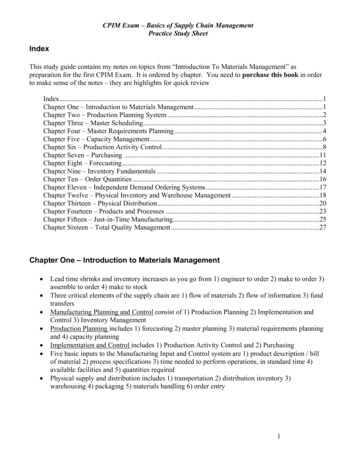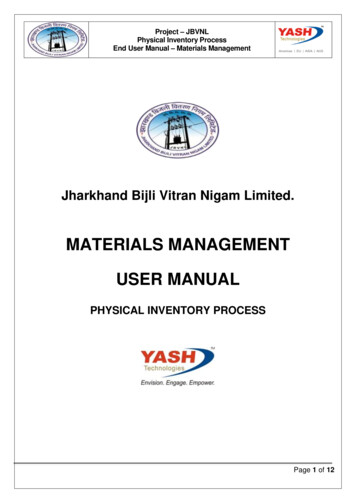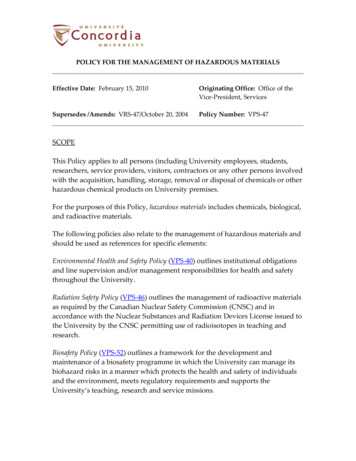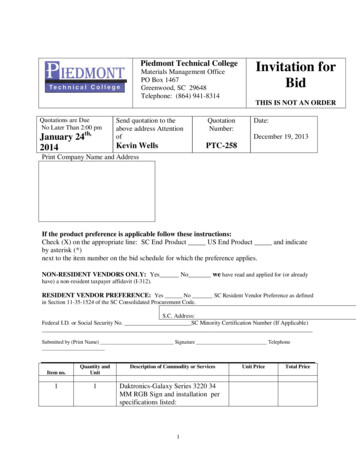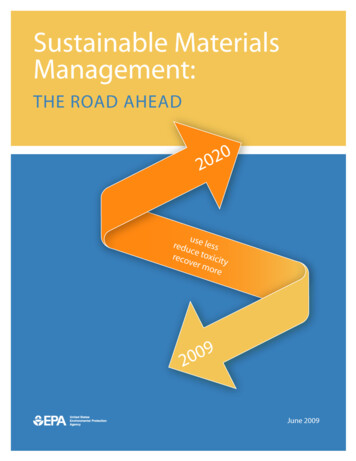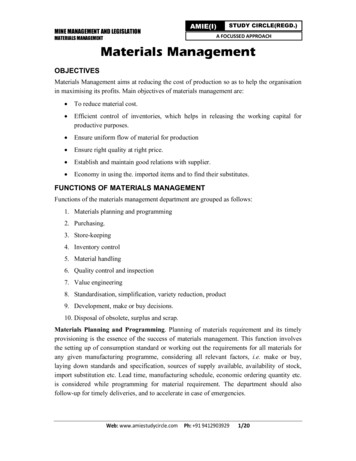
Transcription
MINE MANAGEMENT AND LEGISLATIONAMIE(I)STUDY CIRCLE(REGD.)A FOCUSSED APPROACHMATERIALS MANAGEMENTMaterials ManagementOBJECTIVESMaterials Management aims at reducing the cost of production so as to help the organisationin maximising its profits. Main objectives of materials management are: To reduce material cost. Efficient control of inventories, which helps in releasing the working capital forproductive purposes. Ensure uniform flow of material for production Ensure right quality at right price. Establish and maintain good relations with supplier. Economy in using the. imported items and to find their substitutes.FUNCTIONS OF MATERIALS MANAGEMENTFunctions of the materials management department are grouped as follows:1. Materials planning and programming2. Purchasing.3. Store-keeping4. Inventory control5. Material handling6. Quality control and inspection7. Value engineering8. Standardisation, simplification, variety reduction, product9. Development, make or buy decisions.10. Disposal of obsolete, surplus and scrap.Materials Planning and Programming. Planning of materials requirement and its timelyprovisioning is the essence of the success of materials management. This function involvesthe setting up of consumption standard or working out the requirements for all materials forany given manufacturing programme, considering all relevant factors, i.e. make or buy,laying down standards and specification, sources of supply available, availability of stock,import substitution etc. Lead time, manufacturing schedule, economic ordering quantity etc.is considered while programming for material requirement. The department should alsofollow-up for timely deliveries, and to accelerate in case of emergencies.Web: www.amiestudycircle.comPh: 91 94129039291/20
MINE MANAGEMENT AND LEGISLATIONAMIE(I)STUDY CIRCLE(REGD.)A FOCUSSED APPROACHMATERIALS MANAGEMENTFor the purpose of material planning two concepts are followed depending upon the category.Direct production materials are planned on ‘requirement basis’, while the stock items areplanned on the basis of norms of consumptionMaterials Purchase. Purchasing function includes locating and development of sources ofsupply, market research for purchasing, calling for tenders, selection of suppliers, negotiating,entering into rate contract and issue of purchase orders mentioning specifications, deliveryschedule and other terms and conditions.Purchasing function also include suppliers performance evaluation, preparation of materialsbudget (or called as purchase budget) with the help of material planning and inventorycontrol sections.Store-Keeping. Store-keeping involves receipt custody and issue of materials. The materialsreceived against purchase orders placed by purchase section, are kept in stores after they areinspected and checked for quality as per specifications, physical condition and quantity. Thematerials are kept in stores in such a way that they require minimum handling and remainwell protected against any damage or loss. Material is issued from the stores against theauthorized indents or store issue vouchers and proper record is maintained for receipt andissues of materials.Physical verification and salvage and disposal of surplus material is another key function ofstore-keeping.Inventory Control. Inventory control is a systematic location, storage and recording ofgoods in such a way that desired degree of service can be made to the operating shops atminimum ultimate cost. Inventory control has following functions: To run the stores effectively. To ensure timely availability of material and avoid build up of stock. Technical responsibility for the state of materials. Stock control systems be developed and followed. To maintain specified raw materials. To protect the inventories. Pricing of material supplies. To develop policies, plans and standard essential to achieve inventory controlobjectives. To maintain overall control by checking results and adopting corrective actions.Material Handling. Various functions related to storekeeping requires lot of handling.Starting from receipt of material, inspection, storage and issue items should be handled insuch a way that it requires minimum handling. For large stores suitable material handlingequipment like cranes, hoists, forklifts, conveyors etc. are required.Web: www.amiestudycircle.comPh: 91 94129039292/20
MINE MANAGEMENT AND LEGISLATIONAMIE(I)STUDY CIRCLE(REGD.)A FOCUSSED APPROACHMATERIALS MANAGEMENTScientific material handling system not only economies handling but also space, providesbetter working condition, and effective distribution system. .Quality Control and Inspection. Quality control in simplest terms, is the control of qualityduring manufacturing. Quality of a product itself comprises several engineering andmanufacturing characteristics which go to make the product meet the performanceexpectations of the designer and the customers. These characteristics are: dimensions,chemical properties, sensory property. In other words quality includes appearance,performance, life, dependability, reliability, durability, maintainability, smell, taste, feel,sound etc.Inspection is the process of sorting good from bad, and rejects the bad. Inspection is definedas the art of comparing materials, products, or performances with established standards. Theobjectives of the Inspection are; to detect errors in manufacturing system, to protect thecustomer from receiving a product that is below the quality level, and to compile informationregarding the conformance of the product with specifications for the use of engineering,production, purchasing, quality control and other divisions.INVENTORY MANAGEMENTInventory means all the materials (may be raw or finished parts/components, in process orfinished products, castings and consumable tools, electrodes etc.) recorded on theledgers/books of the organization and kept in its stocks (in the store or ware houses) for someperiod of time.So inventory is an essential part of an organization. Every enterprise/business ormanufacturing concern however big or small, has to maintain some inventory. Some.definitions explaining the various aspects of inventory are as follows: Inventories are referred to raw materials and finished goods lying in stores. All items, parts/components, materials, in process or finished products recorded in thebooks of the organization and kept in the stores are called inventories. Inventory is list of names, with complete specifications, quantities and/or moneyvalues of usable items. Inventory is defined as a descriptive list or items/goods which gives quantity andmoney value of each item. Inventory includes raw materials, semi-finished productsor work in process inventories, finished parts/components and finished final productsetc. held in storage awaiting use or marketing.Functions Or Characteristics Of InventoryFrom the definition of inventory, it is clear that it is related to stock of raw materials, semifinished and finished products items maintained by the enterprise/business/organization. Thefollowing points will explain the concept and functions of inventory.Web: www.amiestudycircle.comPh: 91 94129039293/20
MINE MANAGEMENT AND LEGISLATIONMATERIALS MANAGEMENTAMIE(I)STUDY CIRCLE(REGD.)A FOCUSSED APPROACHInventories Serve as Cushions. Against shocks due to demand/supply fluctuations, itseparates different manufacturing operations from one another and make them independentso that each operation can be performed economically. For example, an organization has todeal with several consumers and vendors and due to their unpredictable behaviour there arealways fluctuations in demand or supply of goods which disturbs the schedule of theenterprise. Inventories absorb these fluctuations and help in maintaining undisturbedproduction i. e. we decouple the manufacturing activities from the consumer and vendorsuccessfully by cushions of stocks. Further more purchasing/order of raw material can becarried out independently of the finished products distribution and both of these activities canbe made low cost operations say by ordering raw material and distributing products in onebig lot than in small batches. Thus it leads to better utilization of men and machines besideseconomy.Inventory, a Necessary evil for any Enterprise. Inventories require valuable space, capitaland other overheads for maintaining it. The invested capital remains idle till the stocks are notconsumed. On the other hand, smooth working of the organization is not possible withoutinventory so it is a necessity. Further it has been observed that costs of not having inventory(stock out conditions) are usually greater than costs of having them. Thus inventory is anecessary evil.Inventory Provides Production Economies. Purchase in desired quantities nullifies theeffects of change in prices or supply. Stocks bring economy in purchase of various inputs dueto discounts on bulk purchase.Maintenance of Smooth and Efficient Production Flow. Maintains smooth and efficientproduction flow thus keeps a process continually operating.Creation of Motivational Effect in Decision Making. Creates motivational effect indecision and policy making e.g. a person may be tempted to purchase more if inventories aredisplayed in bulk.Importance Of InventoryThe following points give the importance of inventory to an organization: Good consumer service can be provided and maintained in the organization. Enables smooth and efficient production flow of goods items. Provides protection against uncertainties regarding demand and supply of materialsand output. Various production activities can be independently and economically performed. Ensure better utilization of men, machines and materials. With bulk purchases quantity discounts can be availed.Web: www.amiestudycircle.comPh: 91 94129039294/20
MINE MANAGEMENT AND LEGISLATIONAMIE(I)STUDY CIRCLE(REGD.)A FOCUSSED APPROACHMATERIALS MANAGEMENTTypes Of InventoryThe term inventory includes all types of goods/items available in the stores, however, itexcludes the machinery, jigs and fixtures. Inventories can be classified in different waysdepending on their function or convention. The classification of inventory is mentionedbelow.Classification According to Function or Material Flow Production Inventory. Items/goods going into final product such as raw materials,components finished parts/components sub assemblies procured from market oroutside source. Work In Process Inventory. Items in semi finished stage or products required atdifferent stages of manufacturing of the product. Finished Goods Inventory. These are finished goods or final products ready fordispatch to users or to distributors. Operating and Maintenance Inventory. These include the items which do not formthe part of the final product but are either consumables used during the manufacturingprocess or items needed required for repair and maintenance functions. Miscellaneous Inventory. The items/goods other than those mentioned above such asobsolete and unsaleable products or scrap arising from main production process,stationery items used in office, other items required by office, factory and salesdepartment etc.In fact inventory is maintained for flow of operations only and as such remains inflow, like raw materials inventory maintained for smooth flow of production andfinished goods inventory is maintained for smooth flow of goods under distribution. .Conventional ClassificationInventory may be classified according to convention in the following way: Direct Inventories. These include materials in any form and of any form afterprocessing or finished components which becomes an integral part of the main/finalproduct to be delivered to distributor or consumer. Indirect Inventories. These include materials which are not processed and do notbecome an integral part of the final product but without which the completion of thefinal product is not possible. These may be cutting fluids. lubricants and otherconsumables items required during production. Finished Products Inventories. Products ready for dispatch to the distributionsystem or market i.e. final products. Purchased Parts Inventories. Semi-finished, finished parts purchased from themarket for utilisation at the time of assembly of the final product.Web: www.amiestudycircle.comPh: 91 94129039295/20
MINE MANAGEMENT AND LEGISLATIONAMIE(I)STUDY CIRCLE(REGD.)A FOCUSSED APPROACHMATERIALS MANAGEMENTObjectives/Reasons for Holding InventoryAny comprehensive system of control covering all types of inventory is directly or indirectlyaimed at accomplishing a great variety of purposes. Most of them are as follows:Financial Objectives. The major financial objective of holding the inventory is to keep theinvestment involved within the enterprise’s cash position so that the working capital is notthrown seriously out of balance.To Create a Buffer Stock Between the Input and Output. So that, the out going flow ofproducts is as little dependent on the input material characteristics as possible.To Ensure Against Delay in Deliveries. The delay in delivery of finished product to thebuyer is avoided by holding inventory stock of finished goods.To Allow for a Possible Increase in Output if so Required. Market requirements maydisturb the manufacturing programme of the enterprise. Depending upon the productionrequirements stocks are to be maintained and supplied.To Ensure Against Scarcity of Materials in the Market. Sometimes input materials maybecome scarce and difficult to get when there are large fluctuations in output and demand forthem. A reserve stock of raw materials is must for smooth manufacturing operations.To Make Use of Quantity Discounts. Input materials and components/parts may be cheaperwhen purchased in bulk quantities owning to quantity discounts and lower transportationcosts/charges.To Utilize to Advantage Price Fluctuations. Price fluctuation may have a marked effect onthe procurement policy of an enterprise or organization. If these fluctuations are to be utilizedto advantage of the unit, materials have to be purchased in adequate quantities when pricesare lowest.All the above reasons or objectives involve cost. The inventory control is mainly concernedwith making optimum decisions regarding above variables which are subject to control.INVENTORY COSTSOrdering costsOrdering costs, also known as setup costs, are essentially costs incurred every time you placean order from your supplier.Examples include: Clerical costs of preparing purchase orders — there are many kinds of clerical costs,such as invoice processing, accounting, and communication costs Cost of finding suppliers and expediting orders — costs spent on these will likely beinconsistent, but they are important expenses for the business Transportation costs — the costs of moving the goods to the warehouse or store.These costs are highly variable across different industries and itemsWeb: www.amiestudycircle.comPh: 91 94129039296/20
MINE MANAGEMENT AND LEGISLATIONMATERIALS MANAGEMENTAMIE(I)STUDY CIRCLE(REGD.)A FOCUSSED APPROACH Receiving costs — these include costs of unloading goods at the warehouse andinspecting them to make sure they are the correct items and free of defects Cost of electronic data interchange (EDI) — These are systems used by largebusinesses and especially retailers, which allow ordering process costs to besignificantly reduced.Holding costsAlso known as carrying costs, these are costs involved with storing inventory before it issold. Inventory financing costs — this includes everything related to the investment madein inventory, including costs like interest on working capital. Financing costs can becomplex depending on the business Opportunity cost of the money invested in inventory — this is found by factoring inthe lost alternatives of tying money up in inventory, such as investing in term depositsor mutual funds Storage space costs — these are costs related to the place where the inventory isstored and will vary by location. There will be the cost of the storage facility itself, orlease payments if it is not owned. Then there are facility maintenance costs likelighting, heating, and ventilation. Depreciation and property taxes are also included inthis Inventory services costs — this includes the cost of the physical handling of thegoods, as well as insurance, security, and IT hardware, and applications if these areused. Expenses related to inventory control and cycle counting are further examples Inventory risk costs — a major cost is shrinkage, which is the loss of productsbetween purchasing from the supplier and final sale due to any number of reasons:theft, vendor fraud, shipping errors, damage in transit or storage. The other mainexample is dead stockShortage costsThese costs, also called stock-out costs, occur when businesses become out of stock forwhatever reason. Disrupted production — when the business involves producing goods as well asselling them, a shortage will mean the business will have to pay for things like idleworkers and factory overhead, even when nothing is being produced Emergency shipments — for retailers, stock-outs could mean paying extra to get ashipment on time, or changing suppliers Customer loyalty and reputation — aside from the loss of business from customerswho go elsewhere to make purchases, the company takes a hit to customer loyalty andreputation when their customers are unhappyWeb: www.amiestudycircle.comPh: 91 94129039297/20
AMIE(I)MINE MANAGEMENT AND LEGISLATIONSTUDY CIRCLE(REGD.)A FOCUSSED APPROACHMATERIALS MANAGEMENTSpoilage costsPerishable inventory stock can rot or spoil if not sold in time, so controlling inventory toprevent spoilage is essential. Perishability is a concern for many industries such as the foodand beverage, pharmaceutical, healthcare and cosmetic industries, all of which are affected bythe expiration and use-by dates of their products. Spoilage not only costs money but alsomeans you fail to realise a return on your initial investment.Inventory spoilage and waste is not simply a result of isolated cases of poor inventorycontrol, spoilage is now a global environmental concern. When you consider that in theUnited States alone, an estimated 200 billion is spent growing, processing, transporting anddisposing of food that is never eaten.Solid inventory control is your front line to preventing spoilage and waste. With the rightinventory system, you can improve forecasting, boost efficiency, access real-time inventorydata and up-to-date information on the lifecycle of your stock, enabling staff to rotate andmanage stock to ensure older products get sold first.This approach is used in the grocery and FMCG sectors where products with shorter expirydates are rotated to the front of the shelf. Items that are due to expire are often heavilydiscounted to clear the inventory stock.INVENTORY CONTROL MANAGEMENTIt may be defined as the scientific way of finding out the quantities to be kept in stock to meetthe production requirements and the systematic location, storage and recordings of thegoods/items in such a way that desired degree of service can be provided at competitiveprices or at minimum ultimate cost.Causes of Poor Inventory Control Over buying without consideration of demand estimates in order to take advantage offavourable market conditions leads to poor control. Over production or keeping inventory stocks of finished products withoutconsideration of customer requirements. In order to provide quick and better service to consumer over-stocking may takeplace. Also to cut down the cost of production, bulk production will result in hugeinventories both these shall lead to poor inventory control. Cancellation of orders may also give rise to large inventories thus may result in poorinventory management.Functions Of Inventory ControlThe functions of inventory control are listed below: To develop policies, plans and standards required: So a
INVENTORY MANAGEMENT Inventory means all the materials (may be raw or finished parts/components, in process or finished products, castings and consumable tools, electrodes etc.) recorded on the ledgers/books of the organization and kept in its stoc

